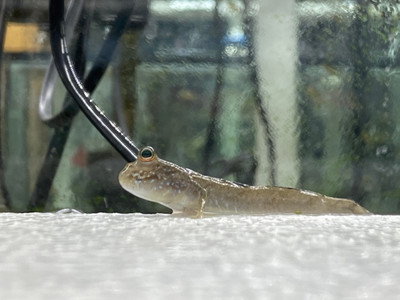African Mudskipper
Posted by Max Gandara on on 16th Aug 2024
The African Mudskipper: A Unique and Fascinating Addition to Your Aquarium
If you’re searching for a truly unique and intriguing fish to enhance your aquarium, look no further than the African Mudskipper. Known for its unusual behavior and remarkable adaptations, this amphibious fish offers a captivating experience for both novice and experienced aquarists. Here’s everything you need to know about the African Mudskipper and why it’s a standout choice for your aquatic setup.
1. Unique Appearance
The African Mudskipper, or Periophthalmus barbarus, is notable for its distinctive appearance. Unlike most fish, it has evolved to thrive both in water and on land. It features a flattened body with strong, robust pectoral fins that allow it to "walk" or skip across the mud. Its large, bulging eyes are positioned on top of its head, giving it an almost prehistoric look and enhancing its ability to spot predators and prey above the waterline.
2. Adaptations for Land and Water
One of the most fascinating aspects of the African Mudskipper is its ability to live in both aquatic and terrestrial environments. It can breathe air and survive out of water for extended periods, making it well-suited to the mangrove swamps and mudflats of its native habitat. This remarkable adaptation allows it to move across the mudflats in search of food and mates, making it a truly amphibious species.
3. Ideal Tank Conditions
To create a suitable environment for your African Mudskipper, follow these tank conditions:
- Tank Size: A minimum of 20 gallons is recommended, but a larger tank will provide more space and a more stable environment.
- Temperature: Maintain a temperature range of 75-85°F (24-29°C), which reflects the warm conditions of their natural habitat.
- pH Level: They prefer a slightly brackish to neutral pH, ideally between 7.0 and 8.0.
- Tank Setup: Set up your tank with both aquatic and terrestrial areas. Include a section with water for swimming and a dry area with mud or sand where the mudskipper can climb out and explore. Incorporate rocks, driftwood, and plants to mimic their natural mangrove environment.
4. Diet and Feeding
The African Mudskipper is an opportunistic feeder and has a varied diet in the wild. In captivity, provide a balanced diet that includes live or frozen foods such as insects, worms, small crustaceans, and fish. You can also offer high-quality pellets or flakes designed for carnivorous fish. Ensure the diet is varied to provide all necessary nutrients and maintain their health and vibrant coloration.
5. Active and Social Behavior
African Mudskippers are known for their active and engaging behavior. They are constantly exploring their environment, both in water and on land. Their "walking" behavior on their pectoral fins is fascinating to observe and adds a dynamic element to your aquarium. They can be quite territorial, especially males, so provide plenty of hiding spots and space to reduce aggression.
6. Tank Mates
Due to their unique behavior and territorial nature, African Mudskippers are best kept with other species that can tolerate their presence. Suitable tank mates include other mudskippers, small, non-aggressive fish, and invertebrates. Avoid housing them with larger or overly aggressive fish that may outcompete them for food or stress them. Creating a well-balanced community will help ensure a harmonious environment.
7. Breeding and Reproduction
Breeding African Mudskippers in captivity is rare but possible. They are known to build nests in mud or sand, where the female lays eggs. The male guards the nest and provides care for the eggs until they hatch. Providing a suitable nesting area and maintaining optimal water and environmental conditions can increase the chances of successful breeding. However, breeding these fish requires specific knowledge and careful monitoring.
8. Benefits of Adding African Mudskippers
Incorporating African Mudskippers into your aquarium offers several benefits:
- Unique Behavior: Their ability to live both in and out of water provides a fascinating display of amphibious behavior.
- Striking Appearance: Their unusual appearance and behavior make them a standout feature in any tank.
- Adaptability: Their adaptability to both aquatic and terrestrial environments adds versatility to your aquarium setup.
9. Care Tips
To ensure the best care for your African Mudskipper:
- Monitor Water Quality: Regular water changes and monitoring of water parameters are essential for maintaining a healthy environment.
- Provide Both Habitats: Create both aquatic and terrestrial areas to accommodate their unique lifestyle.
- Feed Appropriately: Offer a varied diet to ensure they receive all necessary nutrients.
Conclusion
The African Mudskipper is a remarkable and intriguing addition to any aquarium. With its unique amphibious adaptations, striking appearance, and engaging behavior, it adds both beauty and interest to your tank. Whether you’re a seasoned aquarist or new to the hobby, the African Mudskipper provides a captivating and dynamic presence that will enhance your aquatic setup.

